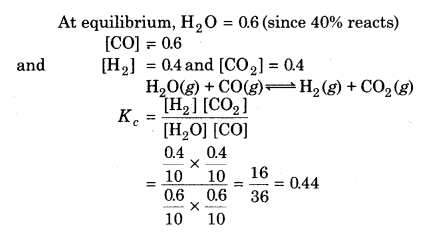Rajasthan Board RBSE Class 11 Chemistry Chapter 7 Equilibrium
RBSE Class 11 Chemistry Chapter 7 Text Book Questions
RBSE Class 11 Chemistry Chapter 7 Multiple Choice Questions
Question 1.
For the reaction A + 2B ➝ C, the equilibrium constant will be :

Answer:

![]()
Question 2.
For the reaction, A (soild) + 2B (Gas) ➝ 3C (solid) + 2D (gas) :
(a) Kp = Kc(RT)°
(b) Kp = Kc(R2T2)
(c) Kp = Kc(RT)
(d) Kp = Kc(R-2T-2)
Answer:
(a) Kp = Kc(RT)°
Question 3.
For the reaction N2 + 3H2 ➝ 2NH3 + xkJ, The conditions to make more ammonia are :
(a) high temperature and high pressure
(b) low temperature and high pressure
(c) low temperature and low pressure
(d) high temperature and low pressure
Answer:
(b) low temperature and high pressure
![]()
Question 4.
The solubility product of two electrolytes AB and AB2 is 1 × 10-10 . The molar conductivity of AB is …… AB2.
(a) equal to
(b) more than
(c) less than
(d) no relation with
Answer:
(c) less than
Question 5.
The pH of a solution on addition of 50 ml. water slowly to a solution
(a) 1
(b) 5
(c) 7
(d) 10
Answer:
(c) 7
RBSE Class 11 Chemistry Chapter 7 Very Short Answer Type Questions
Question 6.
Write the expression for the equlibrium constant, KC for each of the following reaction
(i) 2NOCl(g) ➝ 2NO(g) + Cl2(g)
(ii) 2CU(NO3)2 ➝ 2CuO(s) + 4NO2(g) + O2(g)
(iii) CH3COOC2H5aq + H2O(l) ➝ CH3COOH(aq) + C2H5OH(aq)
(iv) Fe3+ (aq) + 30H– (aq) ➝ Fe(OH)3(s)
(v) I2(s) + 5F2 ➝ 21F5
Answer:
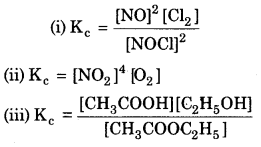
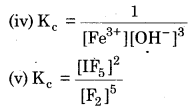
![]()
Question 7.
What is chemical equilibrium ?
Answer:
A dynamic state of a chemical reaction at which the rate of the forward reaction is equal to the rate of backward reaction is called chemical equilibrium.
Question 8.
Write the examples of the reaction in which
(a) Product increases on increasing the pressure
(b) Product increases on increasing the temperature.
Answer:

Question 9.
What will be the effect on equilibrium when ∆n is negative and pressure is decreased ?
Answer:
When ∆n is negative and pressure is decreased then the equilibrium will be shifted to left and the yield of product will decrease.
![]()
Question 10.
What are the conditions for more yield of ammonia by Haber’s proress?
Answer:
Haber’s Process
![]()
Low temperature favours the exothermic reection because it releases energy. So the forward reaction is forward and the yield of ammonia will increase.
High pressure favours the reaction that decreares the number of gas molecules so the forward reaction is favoured. The equilibrium will shift to the right and the yield of ammonia will increase. .
Question 11.
Which states of a substance are at equilibrium at its melting point?
Answer:
![]()
Question 12.
Which states of a substance are at equilibrium at its boiling point?
Answer:
![]()
![]()
Question 13.
If the degree of dissociation of PCl3 and Cl2 is x, them how many moles of PCl5 is present at equilibrium?
Answer:

Moles
No of moles at (1 – x) x x equilibrium
Question 14.
Write the relation for Kww, kα and Kh for KCN salt.
Answer:
![]()
Question 15.
Write the conjugate acid of NH2.
Answer:
NH3
![]()
Question 16.
Write the conjugate base of HCO3
Answer:
\(\mathrm{CO}_{3}^{2-}\)
Question 17.
Calculate the pH of 0.001 N HCl.
Answer:
pH = – log10 [H+] = – log10 [10-3]
= 3log10 = 3 × 1 = 3
Question 18.
What will be the effect of presence of HCl on dissociation of H2S?
Answer:
The dissociation of H2S is suppressed by the presence of HCl due to common ion effect.
Question 19.
What are reversible and irreversible reactions?
Answer:
Reversible reaction : A reaction which takes place in both forward and backward direction is called reversible reaction.
Irreversible reaction: A reaction in which entire amount of reactant is changed into product and no reaction from product side occurs in called irreversible reaction.
![]()
Question 20.
For the following equilibrium, Kc = 63 × 1014 at 1000K
![]()
Both the forward and backward reactions in the equilibrium are elementary bimolecular reactions. What is Kc, for the backward reaction?
Answer:
NO(g) + O3 (g) ➝ NO2 (g) + O2 (g)
Kc = 6.3 × 1014 for forward reaction
For backward reaction,
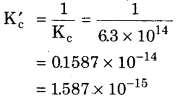
RBSE Class 11 Chemistry Chapter 7 Short Answer Type Questions
Question 21.
Which of the following reactions will get affected by increasing the pressure ? Also, mention whether change will cause the reaction to go into forward or backward direction.
(i) COCl2 ➝ CO(g) + Cl2(g)
(ii) CH4 (g) + 2S2 (g) ➝ CS2 (g) + 2H2S(g)
(iii) CO2(g) + C(s) ➝ 2CO(g)
(iv) 2H2 (g) + CO(g) ➝ CH3OH(g)
(v) CaCO3 (s) ➝ CaO(s) + CO2 (g)
(vi) 4NH3 (g) + SO2 (g) ➝ 4NO(g) + 6H2O (g)
Answer:
(i) COCl2 ➝ CO(g) + Cl2(g)
If pressure increases, the reaction will go into backward direction.
(ii) CH4 (g) + 2S2 (g) ➝ CS2 (g) + 2H2S(g)
If pressure increases, the reaction will go into backward direction.
(iii) CO2(g) + C(s) ➝ 2CO(g)
If the pressure increases, the reaction will go into backward direction.
(iv) 2H2 (g) + CO(g) ➝ CH3OH(g)
If pressure increases, the reaction will go in to forward direction.
(v) CaCO3 (s) ➝ CaO(s) + CO2 (g)
If pressure increases, the reaction will go in to backward direction.
(vi) 4NH3 (g) + SO2 (g) ➝ 4NO(g) + 6H2O (g)
If pressure increases, the reaction will go into backward direction.
![]()
Question 22.
Describe the factors which affect chemical equilibrium?
Answer:
There are following factors which affect chemical equilibrium :
(1) Concentration: If at equilibrium, the concentration of reactants is increased, then rate of forward reaction increases and more amount of product is obtained. If there is increase in concentration of products, then rate of backward reaction increases, more amount of reactant is obtained.
(2) Pressure : The effect of pressure on equilibrium takes place when the reactants are in gaseous state and in those reactions in which number of molecules of reactants and products are different.

In this reaction, the forward reaction is accompanied by a decrease in the total number of moles of reactants. If the pressure of the system is increased, then the equilibrium will shift in that direction where pressure decreases i. e., decrease in number of moles taken i. e., in the favour of formation of ammonia.
If pressure decreases, the equilibrium will shift in the direction where pressure increases i.e., increase in number of moles occurs i. e., in backward direction. So, a decrease in pressure will fovour dissociation of NH3 to form N2 and H2.
When there is no change in number of molecules of reactants and products in a reaction, then there is no effect of pressure on it.
(3) Temperature:
(4) Catalyst : A catalyst increases the rate of the chemical reaction by making available a new low energy pathway for the conversion of reactants to products. It increases the rate of forward and reverse reactions that pass through the same transition state and does not affect equilibrium. Catalyst lowers the activation energy for the forward and backward reactions by exactly the same amount. Catalyst does not affect the equilibrium composition of a reaction mixture. It does not appear in the balanced chemical equation or in the equilibrium constant expression.
![]()
Question 23.
Under what conditions the synthesis of SO3 is more ? Explain.
Answer:
![]()
The conditions for more synthesis of SO3 are given as below:
(i) Increase in concentration of SO2 or O2
(ii) Decerase in temperature
(iii) Increase in pressure
(iv) Removal of SO3 from reaction vessel
(i) Increase in concentration of SO2 or O2
If the concentration of SO2 or O2 will increase, then according to Le-Chatelier’s principle, the equilibrium will shift to forward direction and more SO3 will be formed.
(ii) Decrease in temperature A decrease in temperature favours the exothermic reaction so the equilibrium will shift to forward direction and more amount of SO3 will be formed.
(iii) Increase in Pressure : An increase in pressure will favour the reactions that decrease the number of gaseous molecules. The equilibrium will shift to the right and the yield of SO3 will be increased.
Question 24.
The equilibrium for the synthesis of ammonia is
![]()
What is the effect of pressure, temperature and concentration on this equilibrium ?
Answer:
Effect of pressure :
High pressure favours the formation of ammonia. An increase in pressure will favour the reaction that decreases the number of gas molecules. The equilibrium will shift to the right and the yield of ammoina will be increased.
Effect of temperature:
Low temperature favours the formation of ammonia, a decrease in temperature favours the exothermic reaction because it releases energy, it will favour the forward reaction and the yield of ammonia will be increased.
Effect of concentration
High concentration of reactants favours the formation of ammonia, According to Le-Chatelier’s principle, if the concentration of N2 or H2 is increased then equilibrium will shift to forward direction and the yield of ammonia will be increased.
![]()
Question 25.
Identify acid-base according to Lewis concept
S2-, H+, OH–, BF3, Ni2+ , F–
Answer:
According to Lewis concept, acids are electron pair acceptor and bases are electron pair donor.
Lewis acid : H+, BF3, Ni2+
Lewis basis : S2-, OH–, F–
Question 26.
Write the conjugate acid of the following:
S2-, NH3, H2 \(\mathrm{PO}_{4}^{-}\), CH3NH2
Answer:
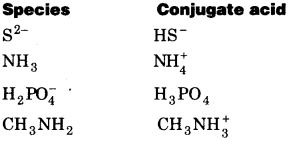
Question 27.
Write any two factors which affect ionization.
Answer:
- Concentration : In a solution, on increasing the concentration of electrolyte, ionization decreases. The extent of ionization of an electrolyte is inversely proportional to the concentration of its solution.
- Temperature : The degree of ionization increases with increase in temperature.
![]()
Question 28.
In precipitation of saturated solution of common salt, HCl gas is added and not HCl acid. Explain why?
Answer:
In precipitation of saturated solution of a common salt, HCl gas is added and not HCl acid because if we add HCl acid to a saturated solution of common salt, the equilibrium of equation (1) will be shifted to left side by increasing concetration of Cl– (eq). As a result, NaCl will recrystallize in the solution.
NaCl ➝ Na+ + Cl– …(1)
HCl ➝ H+ + Cl– …(2)
Question 29.
Derive the formula for Kh and [H+] concentration for a solution of strong acid and weak base.
Answer:
Consider an example of NH4 Cl. It ionizes in water completely into \(\mathrm{NH}_{4}^{+}\) and Cl– ions. \(\mathrm{NH}_{4}^{+}\) ions react with water to form a weak base (NH4 OH) and H3O+ ions.

∴ H3O+ ion concentration increases and the solution becomes acidic.
Applying law of mass action,
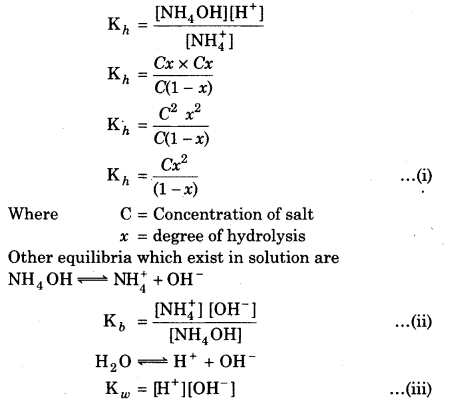
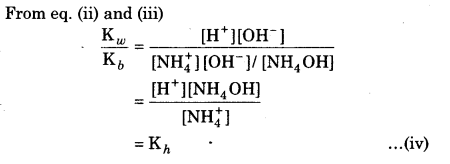
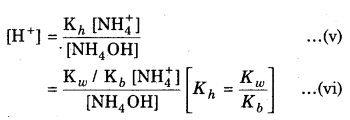
Question 30.
Mg (OH)2 is soluble in NH4Cl but insoluble in NaCl. Explain why?
Answer:
Mg(OH)2 is soluble in NH4 Cl but insoluble in NaCI because the Mg2+ is less reactive than Na+ ion. Ammonium chloride, being a soluble salt, dissociates completely to form ammonium cation and chloride ions.
![]()
The \(\mathrm{NH}_{4}^{+}\) ions can act as an acid and neutralize the OH– ions to form ammonia and water.
![]()
∴ The \(\mathrm{NH}_{4}^{+}\) cations will neutralize the hydroxide anions present in solution. Due to which, the equilibrium will shift to the right to create more OH– ions. This will determine more ions to be dissolve from the solid.
Mg(OH)2 + 2NH4 Cl ➝ MgCl2 + 2NH4OH
However, magnesium ion can not displace the sodium ion since the later is more reactive than the former.
Mg(OH)2 +NaCl ➝ No reaction
![]()
Question 31.
Experimentally how it is proved that chemical equilibrium is dynamic in nature?
Answer:
![]()
In the above equilibrium, on adding radioactive isotope of iodine, there is no change in relative concentrations of hydrogen, iodine and hydrogen iodide. This shows that the reaction is taking place in both the directions at the same rate. The formation of radioactive reaction is taking place in forward direction but the same concentrations shows same rate of reaction in both the directions. Thus, chemical equilibrium is a dynamic equilibrium.
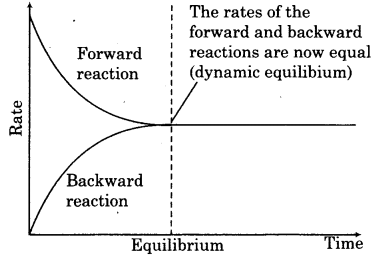
Question 32.
Establish the relation between concentration equilibrium constant KC and pressure equilibrium constant KP for the following homogeneous reaction—
4NH3 (g) + 5O2 (g) ➝ 4NO (g) + 6H2O (g)
Answer:
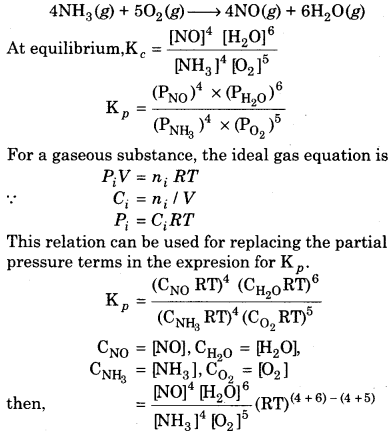
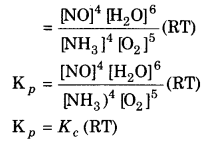
![]()
Question 33.
Explain law of mass Action by taking the following example,
CH3COOH + C2H2OH ➝ CH3COOC2H5 +H2O
Answer:
Law of Mass Action
According to this law, “the rate of reaction of a substance is proportional to the product of molar concentration of reactants at a constant temperature at any given time”. Molar concentration is called active mass. Active mass is the number of moles dissolved in one litre of solution.
eg. CH3COOH + C2H5OH ➝ CH3COOC2 H5 + H2O
According to law of mass action,
Rate of forward reaction a [CH3COOH] [C2H5OH]
= K1 [CH3COOH] [C2H5OH]
When K2 = rate constant for backward reaction At equilibrium,
Rate of backward reaction a [CH3COOC2H5] [H2O]
= K2 [CH3COOC2H5] [H2O]
Where K2= rate constant for backward reaction At equilibrium,
Rate of forward reaction = Rate of backward reaction K2 [CH3COOH] [C2H6OH] – K2 [CH3COOC2H5] [H2O]
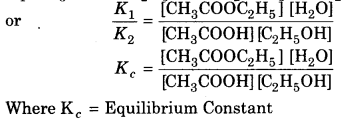
Question 34.
For the system, N2 + O2 ➝ 2NO – 44 kcal, at equilibrium, what will be the effect of the following
(i) Increasing the temperature
(ii) Decreasing the pressure
(iii) Increasing the concentration of NO
(iv) Presence of catalyst
Answer:
For the system,
N2 + O2 ➝ 2NO – 44 kcal
At equilibrium,
(i) Increasing the temperature : An increase in temperature favours the endothermic reaction because it takes up energy so it will favour the forward reaction and the yield of NO will increase.
(ii) Decreasing the pressure : Since the number of molecules of reactants and products are same, so decrease in pressure will not affect the equilibrium.
(iii) Increasing the concentration of NO : On increasing the concentration of NO, it will favour backward reaction and the yield of NO.
(iv) Presence of catalyst : It increase the rate of reaction by lowering the activation energy.
![]()
Question 35.
What will be the effect of temperature and pressure on the following equilibrium?
N2 + 3H2 ➝ 2NH3
Answer:
Effect of temperature
Low temperature favours the forward reaction. A decrease in temperature favours the exothermic reaction because it releases energy. So, it will favour the forward reaction. The yield of ammonia will increase.
Effect of pressure
An increase in pressure will favours the reaction that decreases the number of gaseous molecules. There are fewer molecules of product then reactants so it will favour the forward reaction. The yield of ammonia will increase.
RBSE Class 11 Chemistry Chapter 7 Long Answer Type Questions
Question 36.
(i) Explain equilibrium in physical process and chemical process with examples.
(ii) Prove that degree of dissociation of PC15 is inversely proportional to square root of its pressure.
Answer:
Equilibrium in Physical Process
In a reaction, when there is change in physical state only, it is known as physical process. When equilibrium is established in a physical process, it is called physical equilibrium. The characteristics of a system of equilibrium are better understood if we examine some physical processes. The most familiar examples are phase transformation processes. For example,
Solid ➝ Liquid
Liquid ➝ Gas
Solid ➝ Gas
Solid – Liquid Equilibrium
Conversion of ice into water is an important example of solid- liquid equilibrium.

Ice and water kept in a perfectly insulated thermos flask (no exchange of heat between its contents and the surroundings) at 273K and the atmospheric pressure are in equilibrium state. The melting and freezing point of water is 273K. It is obvious that the ice and water are in equilibrium only at particular temperature and pressure. At equilibrium, the mass of ice and water does not change with time and the temperature remains constant as rate of transfer of molecules from ice to water and of reverse transfer from water into ice. are equal at atmospheric pressure and 273 K. The equilibrium is not static. Molecules from the liquid water collide against ice and adhere to it and some molecules of ice escape into liquid phase.
Freezing Point: For a pure substance, at atmospheric pressure, the temperature at which the solid and liquid phases are at equilibrium is called the normal melting point or normal freezing point of the substance. The system here is in dynamic equlibrium. There is change in melting point of substance on changing the pressure.
Equilibrium in Chemical Processes
The state of chemical equilibrium depends on temperature, pressure, concentration of reactants and products and presence of other substances. At equilibrium, all the above factors are constant. If there is any change in any of the above factors, then it affects the equilibrium also. As a result, rate of forward or backward reaction increases. As the equilibrium is reversible in nature, new equilibrium state is attained in the changing direction. It appears as equilibrium is shifted from one state to another. It also shows dynamic nature of equilibrium.
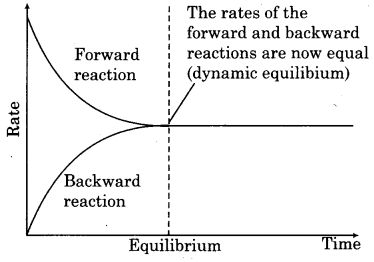
Example:
![]()
In the above equilibrium, on adding radioactive isotope of iodine, there is no change in relative concentrations of hydrogen, iodine and hydrogen iodide. This shows that the reaction is taking place in both the directions at the same rate. The formation of radioactive hydrogen iodide shows that reaction is taking place in forward direction but the same concentrations show same rate of reaction in both the directions. Thus, chemical equilibrium is a dynamic equilibrium.
(ii) Let us consider that one mole of PCl5 is present initially. At equilibrium, let us assume that x mole of PClx dissociates to give x mole of PCl5 and x mole of Cl2. Let the total pressure at equilibrium be P atmosphere. The number of moles of PCl5, PCl3 and Cl2 present at equilibrium can be gives as follows :

Totla number of moles at equilibrium,
= 1 – x + x + x
= 1 + x
We know that partial pressure is the product of mole fraction and the total pressure. Mole fraction is the number of moles of that component divided by the total number of moles in the mixture. Therefore,
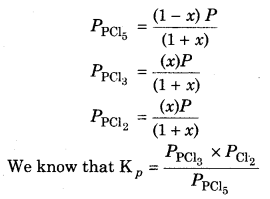
Substituting the values of partial pressure in this expression

When x << 1
The value of x2 can be neglected when compared to one.

Question 37.
What is buffer solution ? Write any two properties of buffer solution. Derive the formula for calculating the pH for acidic buffer. Write any two examples of simple buffer.
Answer:
Buffer solution : The solution which resists change in pH on dilution or with the addition of small amounts of acid or alkali is called buffer solution.
Properties of buffer solution
- Buffer solution resists change in pH.
- It is used to prepare a buffer solution of particular pH.
pH of Acidic buffer
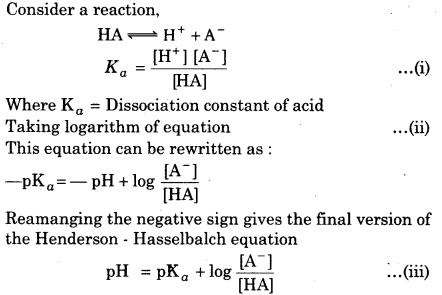
Examples of Simple buffere
- CH3COONH4
- (NH4)2CO3
![]()
Question 38.
What is solubility product? Establish the relation between solubility and solubility product for CdS type compounds. In third group analysis, NH4 Cl is added before NH4 OH, Why?
Answer:
Solubility Product: It is defined as the product of the concentration of ions in a saturated solution of an electrolyte at a given temperature. It is repersented by the symbol Ksp.
Relation between solubility and solubility product for CdS type compounds
Let x be the solubility of CdS
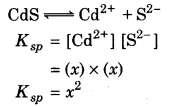
In third group analysis, NH4 Cl is added before NH4 OH because \(\mathrm{NH}_{4}^{+}\) ions furnished by NH4Cl lower the ionization of NH4 OH and hence the concentration of OH– ion. At low concentration of OH– ion, III group hydroxides precipitate.
Whereas, when NH4OH is added in the presence of NH4 Cl, the precipitation of II group hydroxides takes place.
![]()
Question 39.
Explain law of mass action taking suitable chemical reaction. Derive the relationship between Kp and Kc for a homogeneous
Answer:
Law of Mass Action:
According to this law,
“The rate of reaction of a substance is proportional to the product of molar concentration of reactants at a constant temperature at any given time.”
Molar concentration is called active mass. Active mass is the number of moles dissolved in one litre of solution. Let a reaction;
A + B ➝ C + D
According to law of mass action ;
Rate α [A] [B]
Rate = k1 [A] [B]
Here, k1 = constant of proportionality or rate constant for forward reaction.
When the concentration of [A] and [B] is unity, k1 shows rate of forward reaction
Rate of backward reaction α [C][[D]
Rate = k2 [C] [D]
Here k2 is rate constant for backward reaction.
At equilibrium,
Rate of forward reaction = Rate of backward reaction
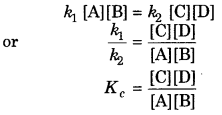
Relationship between Kp and Kc for a homogeneous reaction,
![]()
Suppose ‘a’ moles of H2 and ‘b’ moles of I2 be heated in sealed glass bulb having volume V litres in a thermostat till equilibrium is established. If the concentration of HI formed after analysis is 2x, then according to above reaction, 2x moles of HI will be obtained from x moles of each H2 and I2.
The equilibrium concentration per litre of various reactions and products may be shown as follows :
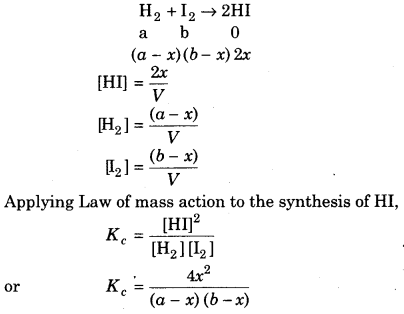
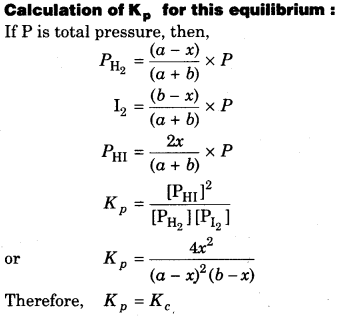
Question 40.
What is an indicator? Explain Ostwald theory of indicator. Explain titration between HNO3 and KOH using suitable indicator with the help of a curve.
Answer:
Indicator : An indicator is a chemical substance that undergoes a colour change at the end point. The end point of an acid-base titration can be determined using acid-base indicators. Acid Base indicators are either weak organic acids or weak organic bases. They change their colour within a certain pH range. Two theories have been proposed to explain the change of colour of acid-base indicators with change in pH.
Ostwald Theory of Indicators:
According to this theory :
(a) The colour change is due to ionisation of the acid-base indicator. The unionised form has different colour than the ionised form.
(b) The ionisation of the indrcation is largely affected in acids and bases as it is either a weak acid or a weak base. In case, the indicator is a weak acid, its ionisation is very much low in acids due to common H+ ions while it is fairly ionised in alkalies. Similarly if the indicator is a weak base, its ionisation is large in acids and low in alkalies due to common OH– ions.
Considering two important indicators, Phenolphthalein (a weak acid) and Methyl orange (a weak base). Ostwald theory can be illustrated as follows:
Phenolphtalein : It can be represented as HPh. It ionises in solution to a small extent as:
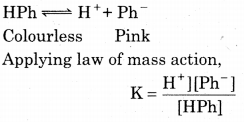
The undissociated molecules of phenolphthalein are colourless while Ph– ions are pink in colour. In presence of an acid, the ionisation of HPh is practically negligible as the equilibrium shifts to left hand side due to high concentration of H+ ions. Thus, the solution would remain colourless. On addition of alkali, hydrogen ions are removed by OH– ions in the form of water molecules and the equilibrium shifts to right hand side. Thus, the concentration of Ph– ions increases in solution and they impart pink colour to the solution.
Titration between HNO3 (strong acid) and KOH (Strong bose)
For this titration, base is taken in a burette and acid is taken in a beaker. The pH of strong acid is very less.
Initially when base is added pH changes gradually but at end point, pH changes rapidly from 3 to 10. The curve obtained when volume of base used and pH change are plotted is known as titration curve. The range of strong acid and strong base is very large. Many indicators come in this range.
The diagram shows the pH curve for adding a strong acid to a strong base. Superimposed on it are the pH ranges for methyl orange and phenolphthalein
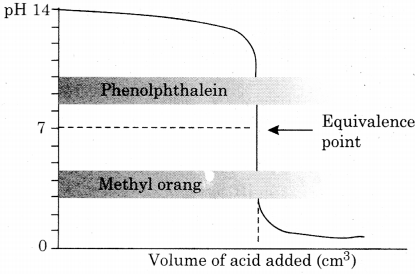
You can see that indicator does not change colour at the equivalence point.
However, the graph is so steep at that point that there will be virtually no difference in the volume of acid added whichever indicator you choose. However, it would make sense to titrate to the best possible colour with each indicator.
If you use phenolphthalein, you would titrate until it just becomes colourless (at pH 8.3) because that is as close as you can get to the equivalence point.
RBSE Class 11 Chemistry Chapter 7 Numerical Problems
Question 41.
The first ionization constant of H2S is
9.1 × 10-8. Calculate the concentratioin of HS– ions in its 0.1 M solution. How will this concentration be affected if the solution is 0.1 M in HCl also? If the second dissociation constant of H2S is 1.2 × 10-13. Calculate the concentration of S2- under both conditions.
Answer:
To calculate the concentration of HS– ion.
Case I: In case of absence of HCl
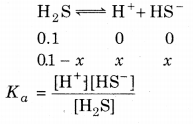
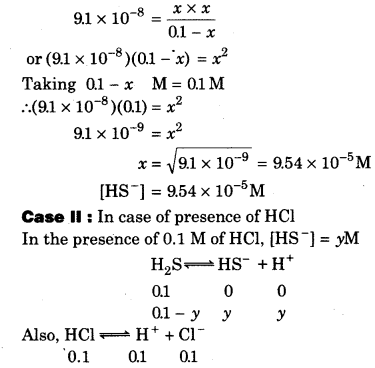
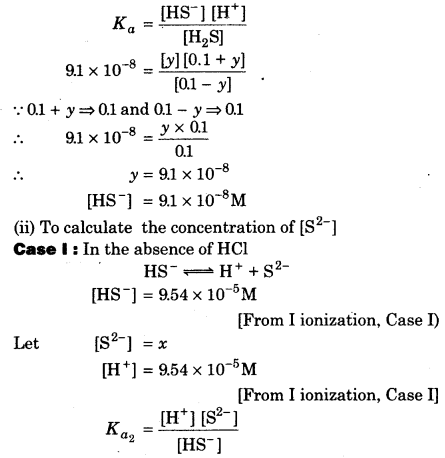
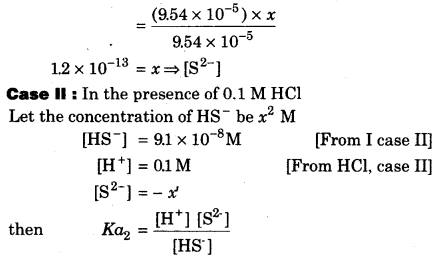
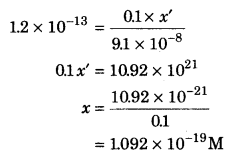
![]()
Question 42.
The ionization constant of propanoic acid is 1.32 × 10-5. Calcualte the degree of ionization of the acid in its 0.05 M solution and also its pH. What will be its degree of ionzation if the solution is 0.01 M HCl also?
Answer:
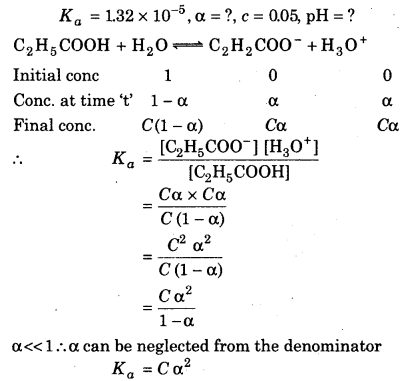
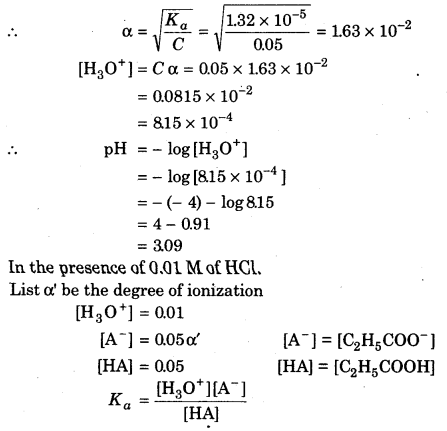

Question 43.
Calculate pH of following mixtures :
(i) 10 mL of 0.2 M Ca(OH)2 + 25 mL of 0.1 M HCl
(ii) 10 mL of 0.01 m H2SO4 + 10 mL of 0.01 m Ca(OH)2
(iii) 10 mL of 0.1 m H2SO4 + 10 mL of 0.1 M KOH
Answer:
(i) 10 mL of 0.2 m Ca(OH)2 + 25 mL of 0.1 m HCl
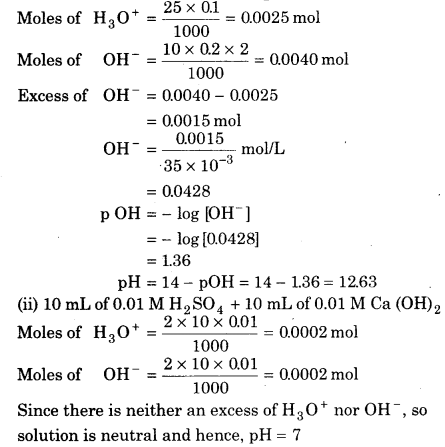
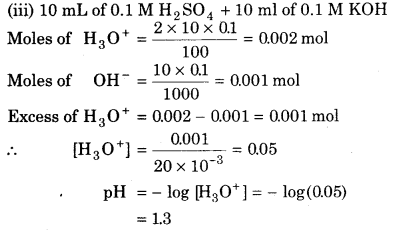
![]()
Question 44.
The solubility product of Ag2CrO4 and AgBr are 11 × 10-12 and 5.0 × 10-13 respectively. Calculate the ratio of the molarities of their saturated solutions.
Answer:
Let solubility of Ag2 CrO4 = S
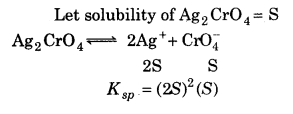
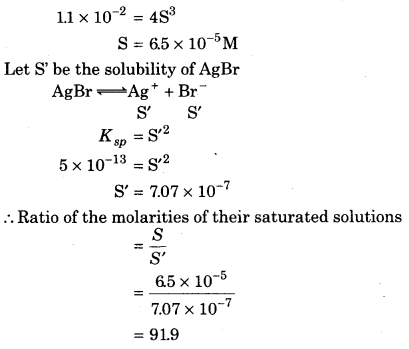
Question 45.
The ionization constant of benzoic acid is 6.46 × 10-5 and Ksp for silver benzoate is 2.5 × 10-13. How many times is silver benzoate more soluble in a buffer of pH 3.9 compared to its solubility in pure water?
Answer:
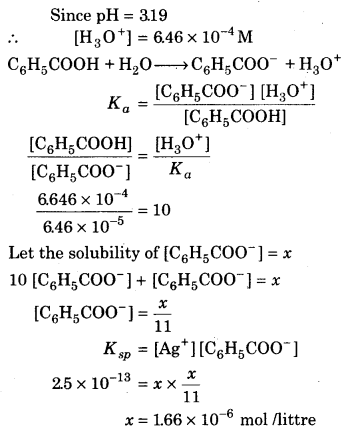
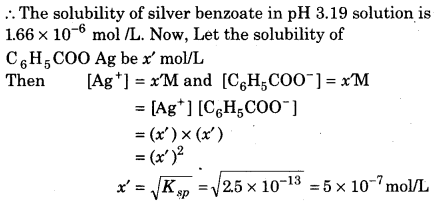

Hence, silver benzoate in 3.32 times more soluble in low pH solution.
![]()
Question 46.
In a reaction, A + 2B ➝ 2C + D, A and B are heated in a flask at 25°C. The inital concentration of B is 1.5 times the concentration of A. At equilibrium, the concentration of A and D is same. Calculate equilibrium constant at this temperature.
Answer:
Let the initial concentration is 1 g mol/ L. So, the initial concentration of B is 1.5 g mol/L. If x mole of D are added, then the concentration in equilibrium can be respresented as :
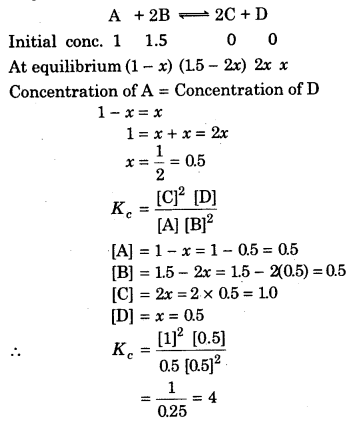
Question 47.
At 25°C and one atmospheric pressure, 20% of N2O4 is dissociated into NO2. Calculate equilibrium constant Kp for this equilibrium.
Answer:
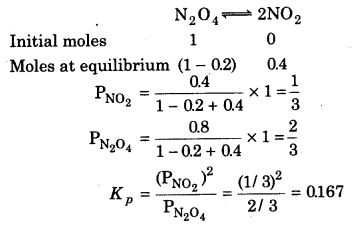
![]()
Question 48.
At normal temperature and pressure, 5.29mL hydrogen reacts with 0.040 gm iodine at 444°C and gives 6.35 mL hydrogen iodide. Calculate equilibrium constant for the synthesis of HI at this temperature.
Answer:
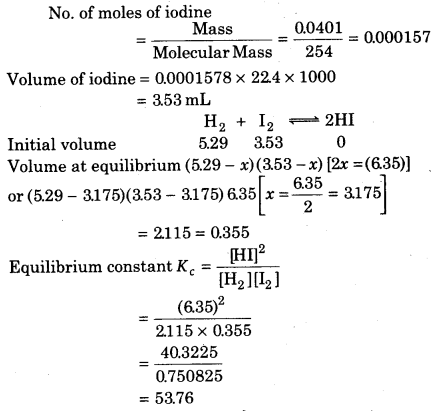
![]()
Question 49.
The molecular mass of PCl5 is 208.3. At 200°C, the mass of partial dissociated vapours is 62 times that of mass of hydrogen. Calculate degree of dissociation of PCl5.
Answer:
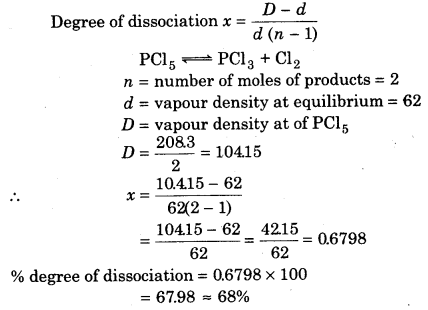
Question 50.
One mole of H2O and one mole of CO are taken in 10L vessel and heated to 725 K. At equilibrium. 40% of water (by mass) reacts with CO according to the equation,
H2O(g) + CO(g) ➝ H2 (g) + CO2 (g)
Calculate the equilibrium constant for the reaction.
Answer:
